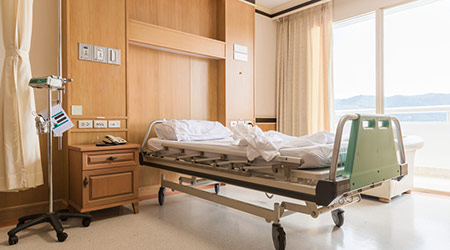When creating a healthcare facility, a great deal of thought goes into the design of the physical space — from making sure patients feel comfortable to medical staff being able to do their jobs at the best of their ability. However, one of the simplest elements of a facility can easily be overlooked: the lighting. Rooms that are poorly-lit will inhibit a healthcare provider’s work while, conversely, rooms harshly-lit with fluorescent lights may not be beneficial to patients. This is where smart lighting solutions can optimize the healthcare experience for both patient and provider.
Smart lighting solutions not only effect staff efficiency, well-being, and safety, they also offer the potential to advance the patient experience. Overnight or extended-stay patients spend most of their days indoors in hospital rooms. Similarly, patients awaiting treatment are forced to sit, sometimes for hours at a time, in the hospital waiting room under the glaring, fluorescent lights.
In a study conducted by Dr. Dorothy Sit, 46 patients were divided and sat in front of either a bright white light or a dim red light for an hour every day for six weeks. At the end of the study, nearly 70 percent of patients that were exposed to the bright light reported a remission in depression, compared to 22 percent from the red light group. Lighting that eases a patient and healthcare professional’s pain, mood, and perception can in turn lead to increased work productivity and overall happiness.
The result of a confused internal clock
A recent study by AARP reports that physicians work an average of 45.5 hours each week in a healthcare facility, such as a hospital, out-patient clinic, nursing home or an assisted living home. This is a great deal of time to spend indoors, away from natural light and vitamin D. Plus, artificial lighting can confuse an individual’s internal clock, having a dramatic effect on one’s circadian rhythm. Circadian rhythm refers to how your body knows to go to sleep and wake up based on sunlight – the sun’s natural light works together with a person’s internal clock to tell the body when to release or suppress melatonin, or when to feel sleepy or awake. When these signals are not received, or when they’re regularly interrupted by prolonged exposure to artificial lights, the internal clock becomes confused, leading to fatigue during the day and insomnia at night.
For example, a patient in the hospital who is in a room lit by harsh fluorescent lights may find it difficult to sleep at night because they weren’t subjected to the changes in light produced by the sun. This can lead to a poor night’s rest and impact patient recovery time. Similarly, healthcare workers who are exposed to these same conditions during the workday may have trouble sleeping when they go home at night. A tired hospital staff can result in reduced productivity, efficiency and, most notably, a reduced level of patient care.
Resyncing the body’s internal clock with light
While spending more time in the sunshine may seem like the only solution to correcting unhealthy sleep patterns, there is an alternative route involving technology to help resync the body’s internal clock. Healthcare facilities across the country are introducing circadian lighting control to help boost productivity, concentration, and patient satisfaction. Circadian lighting takes the color temperature – not intensity – of artificial lights into account and alters it throughout the day for optimal exposure, helping keep the body’s internal clock in check.
In addition to intensity, the color of light can also affect the body’s internal clock. While it may be insignificant, the smallest change in color can directly affect the biological responses in the human body. The “whiteness” of light is measured in Kelvins and represented by color temperature. “Cool” white or bluish lights are given off by high color temperatures, while low color temperatures produce a “warm” yellowish glow. While nearly unperceivable to the human eye, color temperatures greatly affect the body’s circadian rhythm throughout the day. In a healthcare setting, patient rooms or lobbies in the early afternoon can be set to a bright white/blue color temperature to suppress melatonin in the body, resulting in patient or physician productivity and alertness. As the day progresses, the light gradually transitions into a warmer, yellowish color temperature, preparing the body for a better night’s sleep.
Assessing how the hospital environment affects lives is crucial to keeping patients – and medical professionals – happy and healthy patients. Using color temperature to help influence sleep cycles, and in turn productivity throughout the day, is an important way for healthcare facilities to harness the power technology has to enhance not only its patients’ health and happiness, but also its employees’.
Evan Ackmann is a product line manager, lighting and energy management for Crestron.

 Grounding Healthcare Spaces in Hospitality Principles
Grounding Healthcare Spaces in Hospitality Principles UC Davis Health Selects Rudolph and Sletten for Central Utility Plant Expansion
UC Davis Health Selects Rudolph and Sletten for Central Utility Plant Expansion Cape Cod Healthcare Opens Upper 2 Floors of Edwin Barbey Patient Care Pavilion
Cape Cod Healthcare Opens Upper 2 Floors of Edwin Barbey Patient Care Pavilion Building Sustainable Healthcare for an Aging Population
Building Sustainable Healthcare for an Aging Population Froedtert ThedaCare Announces Opening of ThedaCare Medical Center-Oshkosh
Froedtert ThedaCare Announces Opening of ThedaCare Medical Center-Oshkosh